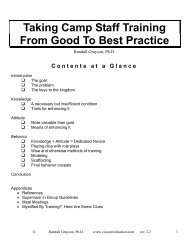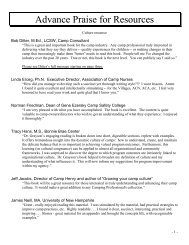Staff motivation - Vision Realization
Staff motivation - Vision Realization
Staff motivation - Vision Realization
Create successful ePaper yourself
Turn your PDF publications into a flip-book with our unique Google optimized e-Paper software.
this will be obvious from the process models, but some interpretation for the different roles<br />
people hold is helpful. The test is to ask staff to take out a blank piece of paper at the end of<br />
orientation and ask them to (a) write out a list of outcomes, and (b) write out the means by<br />
which the camp is going to influence those outcomes. If they can do that and tell you their<br />
specific place in those plans, you’ll have done your job very well. Many kudos.<br />
Once upon a time (really), the boys from a cabin were walking down to the bathhouse<br />
to clean it. Every cabin had a community job to do in the morning. The campers were<br />
complaining, because this was their least favorite job to do. One vocal camper was complaining<br />
bitterly, “Oh man! This sucks! This camp is so bootleg; we paid a lot of money! They should<br />
just hire someone to do this! How come they don’t?” The counselor’s response was “I don’t<br />
know. Look, this is just how it is. We have to do it. Everyone has to do it eventually and today<br />
it’s our turn. If you complain, it’s going to take that much longer. Let’s just get it over with so<br />
we can get on to the fun stuff.” The counselor didn’t get it.<br />
The above counselor’s response isn’t what you would have hoped for. Instead, the<br />
counselor should have replied, “We all live in a community here at camp, and we all need to<br />
contribute. This is our job today and everyone has one. By doing this, we make the camp a nicer<br />
place to live. The camp could pay someone to do it, but that would make the camp more<br />
expensive for everyone to attend. Some people here couldn’t afford it.” If your counselor were<br />
really awesome, she or he might relate it to the broader community: “When people do their part<br />
to recycle or vote, they are all working together to accomplish more than anyone could do by<br />
himself or herself.” Better still would be for the counselor to ask pointed questions so that the<br />
camper could answer his own question. As an aside, if the children picked (choice, power) how<br />
they wanted to contribute to camp, they likely would have been happier about it.<br />
Watching staff who believe in and are committed to enriching lives, and who have the<br />
tools and resources to do so, is an amazing experience. When the vision is not only adopted,<br />
but shaped, refined, assimilated, and perpetuated by staff members who make the vision their<br />
own, going above and beyond average performance becomes the norm. It is expected by<br />
everyone. The visionary cycle, which never really ends, begins to develop a life of its own.<br />
Opportunity<br />
Tools of the trade (standard things)<br />
You probably hire quite a few staff who really love the program area where they’ll<br />
spend much of their time teaching. That’s great, but it comes with a potential cost, because<br />
such a program person often doesn’t feel that their area is supported sufficiently to do their job.<br />
All too often I have witnessed deflated staff who are confronted with the reality of the<br />
equipment at hand and the camp budget. The staff member may then implicitly deduce/think,<br />
“So, this is what the camp really thinks about me, the program area, and the campers.” While<br />
this may be unavoidable to some degree, it can certainly be mitigated by setting realistic<br />
expectations and explaining the realities of a camp budget before the staff member signs up.<br />
Satisfaction on any factor is the discrepancy between reality and expectations. Hiring folks<br />
with expectations that are in line with the realities at camp is a central factor of a motivated<br />
staff. I address setting expectations on page 10 as well. Of course, state-of-the-art equipment<br />
will create satisfaction as well, but it isn’t necessary for a motivated staff as long as the<br />
equipment is capable of meeting the mission point in the eyes of your staff.<br />
Other tools that staff need to achieve the mission outcomes are good training, and good<br />
processes. See the “<strong>Staff</strong> training best practices” resources for an education about what<br />
excellent trainings entail. In terms of process, not all activities yield respectively greater<br />
environmental attitudes, self-esteem, or appreciation for diversity. As I noted with the D.A.R.E.<br />
example in the introduction, there are lots of well-intentioned programs that fail to meet their<br />
© 2004 Randall Grayson, Ph.D. 24





